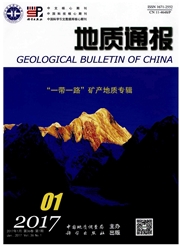

 中文摘要:
中文摘要:
在东喜马拉雅构造结南迦巴瓦岩群中,石榴辉石岩呈透镜状产于麻粒岩相变质的长英质片麻岩和泥质片岩之中。石榴辉石岩主要由富铁铝榴石的石榴子石和透辉石组成,含少量的金红石、榍石和石英,不舍斜长石和角闪石,是榴辉岩相高压变质作用的产物,其原岩相当于基性-超基性层状侵入体中的辉长岩。在高压岩石快速抬升的过程中叠加了麻粒岩相和角闪岩相退变质作用。石榴辉石岩峰期变质作用的温度和压力条件是800-900℃和2.6-2.8GPa,变质时代可能为50Ma。本研究成果,以及超高压变质岩在西喜马拉雅构造结和榴辉岩在珠穆朗玛峰地区的存在,表明整个喜马拉雅造山带,从西构造结到东构造结,都经历了古近纪的高压、超高压变质作用,证明印度板块向欧亚板块之下的俯冲深度至少达到了80-100km。
 英文摘要:
英文摘要:
Garnet pyroxenite occurs as lenses in granulite-facies metamorphic granitic gneiss and pelitic schist in the Namjagbarwa Group-complex of the eastern Himalayan tectonic syntaxis. It consists principally of ahnandine-rich garnet and diopside with minor mtile, sphene and quartz but without plagioclase and amphibole, indicating eclogite-facies metamorphic conditions. Granulite- and amphibolite-facies metamorphism was superimposed during the rapid uplift of high-pressure rocks. The protolith of the garnet pyroxenite corresponds to gabbro in a mafic-ultramafic stratiform intrusion. The peak metamorphic p-T conditions are estimated to be 2.6-2.8 GPa and 800-900℃, indicating a possible metamorphic age of 50 Ma. This fact, combined with the presence of coesite-bearing rocks in the western Himalayan syntaxis and eclogite in the Qomolangma (Everest) area of the eastern Himalayan syntaxis, indicates that the whole Himalayan orogen underwent Paleogene high-pressure and ultrahigh-pressure metamorphism and that the Indian continent was subducted to a depth of at least 80-100 km beneath the Eurasian plate during the collision between the two plates.
 同期刊论文项目
同期刊论文项目
 同项目期刊论文
同项目期刊论文
 期刊信息
期刊信息
